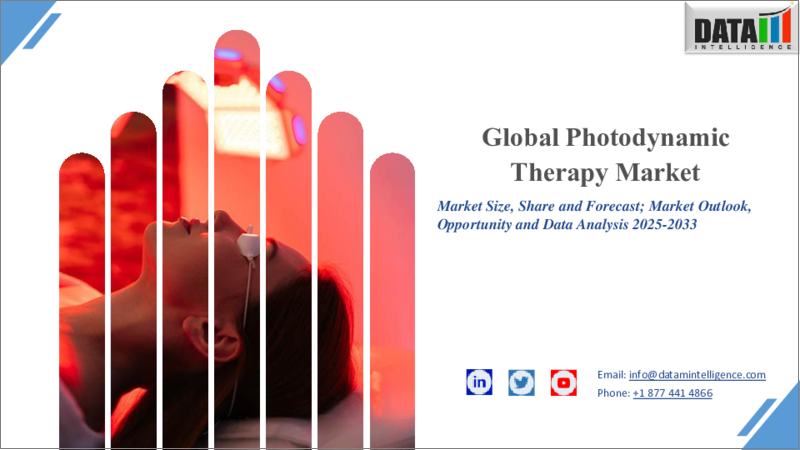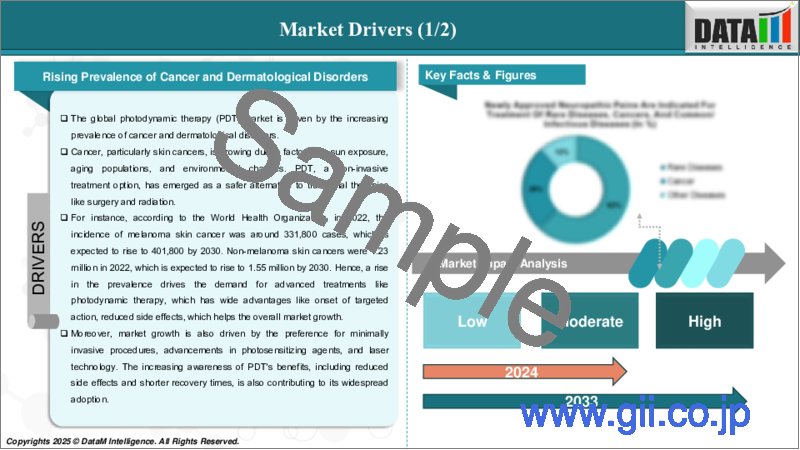|
|
市場調査レポート
商品コード
1634226
光線力学療法の世界市場-2024~2032年Global Photodynamic Therapy Market - 2024 - 2032 |
||||||
カスタマイズ可能
適宜更新あり
|
|||||||
| 光線力学療法の世界市場-2024~2032年 |
|
出版日: 2025年01月13日
発行: DataM Intelligence
ページ情報: 英文 179 Pages
納期: 即日から翌営業日
|
- 全表示
- 概要
- 目次
光線力学療法の世界市場は2024年に53億米ドルに達し、2032年には104億米ドルに達すると予測され、予測期間2024年のCAGRは8.8%で成長します。
光線力学療法(PDT)は、光増感剤と呼ばれる光に反応する物質を用いた最先端の非侵襲的治療法であり、光増感剤は光によって活性化されると、がん、皮膚疾患、感染症など様々な病状の治療に役立ちます。この治療法では、光増感剤を投与し、その光増感剤が異常細胞や病気の細胞に吸収されます。これらの細胞が特定の波長の光にさらされると、光増感剤が活性化され、活性酸素種が生成され、標的となる細胞に選択的にダメージを与えます。
PDTは、外科手術や化学療法といった従来の治療法に比べて副作用が少なく、的確で的を絞った治療ができることから、大きな人気を集めています。特に、皮膚、肺、食道、頭頸部などの早期がんや表面レベルのがんの治療に有効です。がん以外にも、PDTはにきび、加齢黄斑変性(AMD)、特定のウイルス感染症などの治療にも成功を収めています。このようにPDTへの関心が高まっていることは、現代医療における多用途かつ低侵襲な治療オプションとしての可能性を浮き彫りにしています。
市場力学:
促進要因と抑制要因
がんの有病率の上昇
皮膚がん、特に基底細胞がん(BCC)や扁平上皮がん(SCC)のような非黒色腫タイプの有病率の増加は、光線力学療法(PDT)市場を大幅に押し上げると予想されます。このような皮膚がん患者の増加は、長時間の日焼け、日焼け習慣、高齢化などの要因に起因しています。その結果、PDTのような効果的で非侵襲的な治療法の需要が増加しています。世界中で皮膚がんの数は増加しています。例えば、世界がん研究基金によると、2022年には331,722人以上の皮膚がん患者が新たに発生しています。
PDTは皮膚がんの治療において、いくつかの重要な利点を提供します。特に表在性のがんや早期のがんに有効で、皮膚の奥深くまで進行する前に発見されることが多いです。侵襲的な手術を必要とせず、がん細胞を正確に狙い撃ちするPDTの能力は、特に顔や頭皮のような敏感な部位や目につきやすい部位に腫瘍がある患者にとって、非常に魅力的な選択肢となります。さらに、PDTは従来の外科手術と比較して瘢痕や合併症のリスクが低く、皮膚がん治療における魅力を高めています。
皮膚がんの罹患率が上昇を続ける中、医療従事者や患者は、最小限の副作用で局所的な標的治療を提供できるPDTを検討するようになっています。しばらくの間、皮膚がんは増加すると推定されています。皮膚がんの数は予測期間中に増加すると予想されています。例えば、さらにGLOBOCANは、インドのがん患者は208万人に増加し、2020年から2040年には57.5%の増加を占めると予測しています。
さらに、光増感剤と光照射システムの進歩により、PDTの有効性がさらに向上し、皮膚がん管理への応用が広がると予想されます。早期発見と治療がますます重視される中、PDTは皮膚がん患者の世界的急増に対処する上で重要な役割を果たすと思われます。
高コストと限られた入手可能性
光線力学療法(PDT)の高価格と限られた入手可能性は、市場の成長にとって大きな課題となることが予想されます。PDTには特殊な装置や光増感剤が必要であり、その入手や維持には高額な費用がかかるため、多くのヘルスケアプロバイダーや患者にとって高額な治療オプションとなっています。この高コストにより、特にヘルスケアのインフラが整っていない地域や、財源に制約のある低所得国では、その利用が制限される可能性があります。さらに、治療を効果的に行うには訓練を受けた専門家が必要であり、すべてのヘルスケア施設が必要な専門知識や設備を備えているわけではないため、利用可能性はさらに制限されます。
目次
第1章 調査手法と調査範囲
第2章 定義と概要
第3章 エグゼクティブサマリー
第4章 市場力学
- 影響要因
- 促進要因
- がん罹患率の上昇
- 抑制要因
- コストが高く、入手が困難
- 機会
- 影響分析
- 促進要因
第5章 産業分析
- ポーターのファイブフォース分析
- サプライチェーン分析
- 価格分析
- 特許分析
- 規制分析
- SWOT分析
- アンメットニーズ
第6章 製品タイプ別
- 光感受性薬
- ポルフィリン誘導体
- クロリン類
- アミノレブリン酸
- その他
- レーザー装置
第7章 用途別
- 腫瘍学
- 皮膚科
- 眼科
- その他
第8章 エンドユーザー別
- 病院
- 美容・皮膚科クリニック
- がん治療センター
- その他
第9章 地域別
- 北米
- 米国
- カナダ
- メキシコ
- 欧州
- ドイツ
- 英国
- フランス
- スペイン
- イタリア
- その他欧州地域
- 南米
- ブラジル
- アルゼンチン
- その他南米
- アジア太平洋地域
- 中国
- インド
- 日本
- 韓国
- その他アジア太平洋地域
- 中東・アフリカ
第10章 競合情勢
- 競合シナリオ
- 市況・シェア分析
- M&A分析
第11章 企業プロファイル
- Galderma Nordic AB
- 会社概要
- 製品ポートフォリオ
- 製品説明
- 製品の主要業績評価指標(KPI)
- 過去および予測の製品販売
- 製品販売量
- 財務概要
- 会社の収益
- 地域別収益分配
- 収益予測
- 主な発展
- 合併と買収
- 主な製品開発活動
- 規制当局の承認等
- SWOT分析
- BIOFRONTERA AG
- Sun Pharmaceutical Industries Ltd.
- Lumibird Medical
- Bausch+Lomb.
- illumacell
- Pinnacle Biologics, Inc.
- Zimed Healthcare Inc
- MEDlight GmbH
- Luzitin, S.A.
- Similar data will be provided for each market player.
- Regeneron Pharmaceuticals Inc.
- パイプライン製品の説明
- 製品の主要業績評価指標(KPI)
- 主な活動
- 市場参入のタイムライン
- 製品普及率
- 売上予測と予測
- Moderna, Inc.
- Immatics N.V.
- BioNTech SE.
- Philogen S.p.A.
- 各市場参入企業に対しても同様のデータが提供されます。
第12章 付録
The global photodynamic therapy market reached US$ 5.3 billion in 2024 and is expected to reach US$ 10.4 billion by 2032, growing at a CAGR of 8.8% during the forecast period 2024-2032.
Photodynamic Therapy (PDT) is a cutting-edge, non-invasive treatment that uses light-sensitive substances called photosensitizers, which, when activated by light, help to treat a variety of medical conditions, including cancer, skin issues, and infections. The therapy involves administering a photosensitizer that is absorbed by abnormal or diseased cells. When these cells are exposed to a specific light wavelength, the photosensitizer is activated, producing reactive oxygen species that selectively damage the targeted cells.
PDT has gained considerable popularity due to its ability to provide precise, targeted treatment with fewer side effects compared to traditional therapies such as surgery and chemotherapy. It is particularly effective for treating early-stage or surface-level cancers, including those in areas like the skin, lungs, esophagus, and head and neck. Beyond cancer, PDT has shown success in managing conditions such as acne, age-related macular degeneration (AMD), and certain viral infections. This growing interest in PDT highlights its potential as a versatile and minimally invasive treatment option in modern medicine.
Market Dynamics: Drivers & Restraints
Rising prevalence of cancer
The growing prevalence of skin cancer, particularly non-melanoma types such as basal cell carcinoma (BCC) and squamous cell carcinoma (SCC), is expected to significantly boost the Photodynamic Therapy (PDT) market. This increase in skin cancer cases can be attributed to factors like extended sun exposure, tanning practices, and the aging population. As a result, the demand for effective and non-invasive treatment methods like PDT is on the rise. There is a growing number of skin cancers around the globe. For instance, according to the World Cancer Research Fund, there were more than 331,722 new cases of skin cancer in 2022.
PDT offers several key benefits in treating skin cancer. It is especially effective for superficial or early-stage cancers, which are often detected before they progress deeper into the skin. PDT's ability to target cancerous cells precisely without requiring invasive surgery makes it a highly attractive option, particularly for patients with tumors located in sensitive or visible areas, such as the face and scalp. Furthermore, PDT is associated with a lower risk of scarring and complications when compared to traditional surgical procedures, enhancing its appeal in skin cancer treatment.
As the incidence of skin cancer continues to rise, healthcare providers and patients are increasingly considering PDT for its ability to provide localized, targeted treatment with minimal side effects. There is an estimated increase in skin cancer over a while. The number of skin cancers is expected to increase in the forecast period. For instance, additionally, GLOBOCAN predicted that cancer cases in India would increase to 2.08 million, accounting for a rise of 57.5 percent in 2040 from 2020.
Additionally, ongoing advancements in photosensitizers and light delivery systems are expected to further improve PDT's effectiveness, broadening its application in skin cancer management. As early detection and treatment become increasingly emphasized, PDT is likely to play a crucial role in addressing the global surge in skin cancer cases.
High Cost and Limited Availability
The high cost and limited availability of Photodynamic Therapy (PDT) are expected to pose significant challenges to the growth of the market. PDT involves specialized equipment and photosensitizers, which can be expensive to acquire and maintain, making it a costly treatment option for many healthcare providers and patients. This high cost can limit its accessibility, especially in regions with less advanced healthcare infrastructure or in lower-income countries where financial resources are constrained. Additionally, the need for trained professionals to administer the therapy effectively further restricts its availability, as not all healthcare facilities have the necessary expertise or equipment.
Segment Analysis
The global photodynamic therapy market is segmented based on product type, application, end-user, and region.
Type:
Laser devices segment is expected to dominate the global photodynamic therapy market share
The Laser Devices segment is poised to dominate the Photodynamic Therapy (PDT) market due to their critical role in the therapy's mechanism of action. Laser devices are essential for activating the photosensitizers used in PDT, delivering the precise wavelengths of light required to treat a variety of conditions, such as skin cancer, acne, and age-related macular degeneration. The ability of lasers to provide highly targeted, accurate, and deep tissue penetration makes them a preferred choice for PDT, as they allow clinicians to focus the treatment on specific areas without causing damage to surrounding healthy tissues.
The segment's growth is also fueled by ongoing technological advancements and product launches. Manufacturers are continuously improving laser devices to enhance their efficiency, precision, and safety. For instance, companies are introducing lasers that offer more adjustable wavelengths, better depth control, and compact designs, making them easier to use in clinical settings. These innovations are expected to further elevate the adoption of laser devices in PDT. For instance, in February 2023, Bausch + Lomb Corp. and biomedical laser firm Modulight Oyj announced that the US Food and Drug Administration has approved their ML6710i photodynamic laser for use with the eye-health company's photodynamic therapy, Visudyne.
Market players are employing strategies that focus on expanding their product portfolios and advancing their technological capabilities. Leading companies in the PDT space are investing in research and development to create next-generation laser devices that can offer more effective treatment options, including improved portability and user-friendly features. Additionally, strategic partnerships and collaborations with healthcare institutions help to increase awareness and availability of laser-based PDT treatments.
As a result of these advancements, laser devices are expected to maintain their dominance in the PDT market, particularly as the demand for non-invasive, precise, and effective treatments grows. With continued product innovation, strategic market moves, and an increasing focus on patient outcomes, the laser devices segment is set to be a key driver of the Photodynamic Therapy market's expansion.
Geographical Analysis
North America is expected to hold a significant position in the global photodynamic therapy market share
North America is expected to dominate the photodynamic therapy (PDT) market due to a combination of factors including advanced healthcare infrastructure, a high prevalence of diseases treatable with PDT (such as skin cancer and age-related macular degeneration), and a strong presence of key market players and research institutions. The region is a leader in the adoption of innovative medical technologies, making it a hub for the development and deployment of PDT treatments.
The major factor driving the region's photodynamic therapy is the rising incidence of skin cancers in the region. With the growing number of skin cancers, the estimated usage and adoption of photodynamic therapy is expected to increase. For instance, according to the American Academy of Dermatology, skin cancer is the most prevalent cancer in the United States. Current estimates suggest that one in five Americans will be diagnosed with skin cancer during their lifetime. Approximately 9,500 people in the U.S. are diagnosed with skin cancer every day. In 2024, it is projected that there will be 200,340 new cases of melanoma, with 99,700 being noninvasive (in situ) and 100,640 being invasive.
Additionally, North America's dominance is the increasing demand for non-invasive, precise, and targeted therapies. PDT offers a compelling alternative to traditional treatments like surgery and chemotherapy, particularly for conditions like superficial cancers, acne, and eye disorders. As awareness of PDT's benefits grows among both patients and healthcare providers, its adoption is expected to increase. Furthermore, North America boasts a well-established healthcare system that facilitates the widespread availability of advanced treatments such as PDT.
In addition, ongoing product launches and innovations from major market players are contributing to the growth of the PDT market in North America. Companies are introducing new PDT devices, particularly laser-based systems, that offer enhanced precision, improved light delivery mechanisms, and better photosensitizers.
Market players in North America are adopting various strategies to strengthen their positions in the PDT market. Key strategies include increasing investment in research and development to create next-generation PDT technologies, expanding product portfolios, and forging partnerships with hospitals, dermatology clinics, and research institutions. Strategic collaborations are helping to expand the reach of PDT treatments, while partnerships with regulatory bodies and clinical researchers enable quicker approvals and clinical trials, thereby speeding up the adoption of new PDT solutions. Thus, the above factors are expected to hold a significant position in the global photodynamic therapy market.
Competitive Landscape
The major global players in the photodynamic therapy market include Galderma Nordic AB, BIOFRONTERA AG, Sun Pharmaceutical Industries Ltd., Lumibird Medical, Bausch + Lomb., illumacell, Pinnacle Biologics, Inc., Zimed Healthcare Inc, MEDlight GmbH and Luzitin, S.A. among others.
Key Developments
- In July 2023, ImPact Biotech announced that the U.S. Food and Drug Administration (FDA) has granted Orphan Drug Designation (ODD) to Padeliporfin Vascular Targeted Photodynamic Therapy (VTP) for the treatment of patients with locally advanced pancreatic cancer.
- In October 2024, Biofrontera Inc. (Nasdaq: BFRI) announced that the database for the treatment phase of the ALA-BCC-CT013 study has been finalized.
Why Purchase the Report?
- Pipeline & Innovations: Reviews ongoing clinical trials, and product pipelines, and forecasts upcoming advancements in medical devices and pharmaceuticals.
- Product Performance & Market Positioning: Analyzes product performance, market positioning, and growth potential to optimize strategies.
- Real-World Evidence: Integrates patient feedback and data into product development for improved outcomes.
- Physician Preferences & Health System Impact: Examines healthcare provider behaviors and the impact of health system mergers on adoption strategies.
- Market Updates & Industry Changes: Covers recent regulatory changes, new policies, and emerging technologies.
- Competitive Strategies: Analyzes competitor strategies, market share, and emerging players.
- Pricing & Market Access: Reviews pricing models, reimbursement trends, and market access strategies.
- Market Entry & Expansion: Identifies optimal strategies for entering new markets and partnerships.
- Regional Growth & Investment: Highlights high-growth regions and investment opportunities.
- Supply Chain Optimization: Assesses supply chain risks and distribution strategies for efficient product delivery.
- Sustainability & Regulatory Impact: Focuses on eco-friendly practices and evolving regulations in healthcare.
- Post-market Surveillance: Uses post-market data to enhance product safety and access.
- Pharmacoeconomics & Value-Based Pricing: Analyzes the shift to value-based pricing and data-driven decision-making in R&D.
The Global Photodynamic Therapy Market report delivers a detailed analysis with 60+ key tables, more than 50 visually impactful figures, and 176 pages of expert insights, providing a complete view of the market landscape.
Target Audience 2023
- Manufacturers: Pharmaceutical, Medical Device, Biotech Companies, Contract Manufacturers, Distributors, Hospitals.
- Regulatory & Policy: Compliance Officers, Government, Health Economists, Market Access Specialists.
- Technology & Innovation: AI/Robotics Providers, R&D Professionals, Clinical Trial Managers, Pharmacovigilance Experts.
- Investors: Healthcare Investors, Venture Fund Investors, Pharma Marketing & Sales.
- Consulting & Advisory: Healthcare Consultants, Industry Associations, Analysts.
- Supply Chain: Distribution and Supply Chain Managers.
- Consumers & Advocacy: Patients, Advocacy Groups, Insurance Companies.
- Academic & Research: Academic Institutions.
Table of Contents
1. Methodology and Scope
- 1.1. Research Methodology
- 1.2. Research Objective and Scope of the Report
2. Definition and Overview
3. Executive Summary
- 3.1. Snippet by Product Type
- 3.2. Snippet by Application
- 3.3. Snippet by End-User
- 3.4. Snippet by Region
4. Dynamics
- 4.1. Impacting Factors
- 4.1.1. Drivers
- 4.1.1.1. Rising prevalence of cancer
- 4.1.2. Restraints
- 4.1.2.1. High Cost and Limited Availability
- 4.1.3. Opportunity
- 4.1.4. Impact Analysis
- 4.1.1. Drivers
5. Industry Analysis
- 5.1. Porter's Five Force Analysis
- 5.2. Supply Chain Analysis
- 5.3. Pricing Analysis
- 5.4. Patent Analysis
- 5.5. Regulatory Analysis
- 5.6. SWOT Analysis
- 5.7. Unmet Needs
6. By Product Type
- 6.1. Introduction
- 6.1.1. Analysis and Y-o-Y Growth Analysis (%), By Product Type
- 6.1.2. Market Attractiveness Index, By Product Type
- 6.2. Photosensitizer Drugs*
- 6.2.1. Introduction
- 6.2.2. Market Size Analysis and Y-o-Y Growth Analysis (%)
- 6.2.3. Porphyrin Derivatives
- 6.2.4. Chlorines
- 6.2.5. Aminolevulinic Acid
- 6.2.6. Others
- 6.3. Laser Devices
7. By Application
- 7.1. Introduction
- 7.1.1. Market Size Analysis and Y-o-Y Growth Analysis (%), By Application
- 7.1.2. Market Attractiveness Index, By Application
- 7.2. Oncology*
- 7.2.1. Introduction
- 7.2.2. Market Size Analysis and Y-o-Y Growth Analysis (%)
- 7.3. Dermatology
- 7.4. Ophthalmology
- 7.5. Others
8. By End-User
- 8.1. Introduction
- 8.1.1. Market Size Analysis and Y-o-Y Growth Analysis (%), By End-User
- 8.1.2. Market Attractiveness Index, By End-User
- 8.2. Hospitals*
- 8.2.1. Introduction
- 8.2.2. Market Size Analysis and Y-o-Y Growth Analysis (%)
- 8.3. Cosmetic & Dermatology Clinics
- 8.4. Cancer Treatment Centers
- 8.5. Others
9. By Region
- 9.1. Introduction
- 9.1.1. Market Size Analysis and Y-o-Y Growth Analysis (%), By Region
- 9.1.2. Market Attractiveness Index, By Region
- 9.2. North America
- 9.2.1. Introduction
- 9.2.2. Key Region-Specific Dynamics
- 9.2.3. Market Size Analysis and Y-o-Y Growth Analysis (%), By Type
- 9.2.4. Market Size Analysis and Y-o-Y Growth Analysis (%), By Route of Administration
- 9.2.5. Market Size Analysis and Y-o-Y Growth Analysis (%), By Distribution Channel
- 9.2.6. Market Size Analysis and Y-o-Y Growth Analysis (%), By Country
- 9.2.6.1. U.S.
- 9.2.6.2. Canada
- 9.2.6.3. Mexico
- 9.3. Europe
- 9.3.1. Introduction
- 9.3.2. Key Region-Specific Dynamics
- 9.3.3. Market Size Analysis and Y-o-Y Growth Analysis (%), By Type
- 9.3.4. Market Size Analysis and Y-o-Y Growth Analysis (%), By Route of Administration
- 9.3.5. Market Size Analysis and Y-o-Y Growth Analysis (%), By Distribution Channel
- 9.3.6. Market Size Analysis and Y-o-Y Growth Analysis (%), By Country
- 9.3.6.1. Germany
- 9.3.6.2. U.K.
- 9.3.6.3. France
- 9.3.6.4. Spain
- 9.3.6.5. Italy
- 9.3.6.6. Rest of Europe
- 9.4. South America
- 9.4.1. Introduction
- 9.4.2. Key Region-Specific Dynamics
- 9.4.3. Market Size Analysis and Y-o-Y Growth Analysis (%), By Type
- 9.4.4. Market Size Analysis and Y-o-Y Growth Analysis (%), By Route of Administration
- 9.4.5. Market Size Analysis and Y-o-Y Growth Analysis (%), By Distribution Channel
- 9.4.6. Market Size Analysis and Y-o-Y Growth Analysis (%), By Country
- 9.4.6.1. Brazil
- 9.4.6.2. Argentina
- 9.4.6.3. Rest of South America
- 9.5. Asia-Pacific
- 9.5.1. Introduction
- 9.5.2. Key Region-Specific Dynamics
- 9.5.3. Market Size Analysis and Y-o-Y Growth Analysis (%), By Type
- 9.5.4. Market Size Analysis and Y-o-Y Growth Analysis (%), By Route of Administration
- 9.5.5. Market Size Analysis and Y-o-Y Growth Analysis (%), By Distribution Channel
- 9.5.6. Market Size Analysis and Y-o-Y Growth Analysis (%), By Country
- 9.5.6.1. China
- 9.5.6.2. India
- 9.5.6.3. Japan
- 9.5.6.4. South Korea
- 9.5.6.5. Rest of Asia-Pacific
- 9.6. Middle East and Africa
- 9.6.1. Introduction
- 9.6.2. Key Region-Specific Dynamics
- 9.6.3. Market Size Analysis and Y-o-Y Growth Analysis (%), By Type
- 9.6.4. Market Size Analysis and Y-o-Y Growth Analysis (%), By Route of Administration
- 9.6.5. Market Size Analysis and Y-o-Y Growth Analysis (%), By Distribution Channel
10. Competitive Landscape
- 10.1. Competitive Scenario
- 10.2. Market Positioning/Share Analysis
- 10.3. Mergers and Acquisitions Analysis
11. Company Profiles
Key Market Players
- 11.1. Galderma Nordic AB*
- 11.1.1. Company Overview
- 11.1.2. Product Portfolio
- 11.1.2.1. Product Description
- 11.1.2.2. Product Key Performance Indicators (KPIs)
- 11.1.2.3. Historic and Forecasted Product Sales
- 11.1.2.4. Product Sales Volume
- 11.1.3. Financial Overview
- 11.1.3.1. Company Revenue's
- 11.1.3.2. Geographical Revenue Shares
- 11.1.3.3. Revenue Forecasts
- 11.1.4. Key Developments
- 11.1.4.1. Mergers & Acquisitions
- 11.1.4.2. Key Product Development Activities
- 11.1.4.3. Regulatory Approvals etc.
- 11.1.5. SWOT Analysis
- 11.2. BIOFRONTERA AG
- 11.3. Sun Pharmaceutical Industries Ltd.
- 11.4. Lumibird Medical
- 11.5. Bausch + Lomb.
- 11.6. illumacell
- 11.7. Pinnacle Biologics, Inc.
- 11.8. Zimed Healthcare Inc
- 11.9. MEDlight GmbH
- 11.10. Luzitin, S.A.
- Similar data will be provided for each market player.
Emerging Market Players
- 11.11. Regeneron Pharmaceuticals Inc.*
- 11.11.1. Pipeline Products Description
- 11.11.2. Product Key Performance Indicators (KPIs)
- 11.11.3. Key Activities
- 11.11.4. Market Entry Timelines
- 11.11.5. Product Penetration Rate
- 11.11.6. Sales Estimation and Projections
- 11.12. Moderna, Inc.
- 11.13. Immatics N.V.
- 11.14. BioNTech SE.
- 11.15. Philogen S.p.A.
- Similar data will be provided for each market player.
LIST NOT EXHAUSTIVE
12. Appendix
- 12.1. About Us and Services
- 12.2. Contact Us






